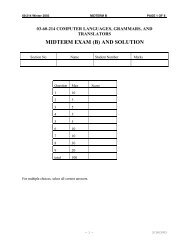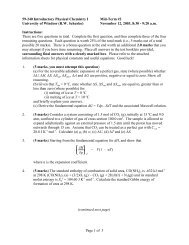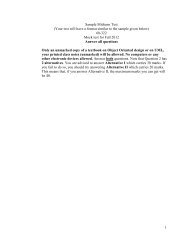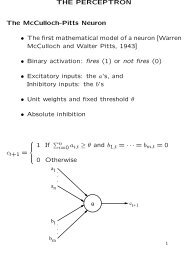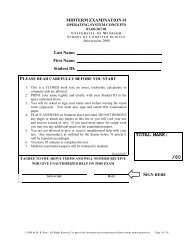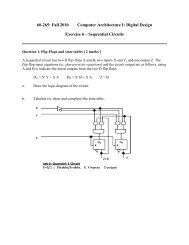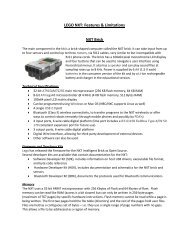Adjectives: A Uniform Semantic Approach - University of Windsor
Adjectives: A Uniform Semantic Approach - University of Windsor
Adjectives: A Uniform Semantic Approach - University of Windsor
Create successful ePaper yourself
Turn your PDF publications into a flip-book with our unique Google optimized e-Paper software.
<strong>Adjectives</strong>: A <strong>Uniform</strong> <strong>Semantic</strong> <strong>Approach</strong> 333<br />
Table 1. Missing properties<br />
Adjective Phrase Property missing from the default set <strong>of</strong> features<br />
Artificial heart e.g. not flesh-and-blood<br />
Artificial flower e.g. doesn’t grow<br />
Artificial light e.g. source<br />
Former senator e.g. temporal continuance<br />
False teeth e.g. not naturally grown<br />
Cloned sheep e.g. not naturally bred<br />
Virtual reality e.g. exists visually only<br />
Imitation leather e.g. genuineness<br />
Wooden lion e.g. “make-ness”—physical and non-living<br />
Fake statue e.g. originality<br />
Fake perfume e.g. substance/originality<br />
In short, intensifier/privative seem to be (semantically) intimately related. If<br />
viewed as functions, they can be thought <strong>of</strong> as functions and their respective inverse<br />
functions. Alternatively, they can be viewed as set partitions <strong>of</strong> the set N, which<br />
represents the denotation <strong>of</strong> the noun an intensifier/privative pair combines with. The<br />
latter view is adopted in the approach proposed in this paper.<br />
In our view, both “regular” adjectives such as ‘red’, ‘angry’, or ‘skillful’ and<br />
privative adjectives such as ‘fake’ or ‘former’ have one thing in common. They both<br />
pick out or further constrain the domain denoted by the noun <strong>of</strong> the compound. They<br />
differ in the means <strong>of</strong> doing it: regular adjectives by highlighting some property or<br />
properties <strong>of</strong> the noun, while privative adjectives by “masking” some property or<br />
properties <strong>of</strong> the noun.<br />
Once the argument <strong>of</strong> augmenting the denotation <strong>of</strong> common nouns is accepted,<br />
expressions such as that senator, that gun, and that heart are considered elliptic<br />
forms, respectively, for that current senator, that real gun, and that natural heart.<br />
However, privative-common-noun combinations should be explicitly specified 4 , i.e.<br />
that former senator, that fake gun, and that artificial heart.<br />
The view that privative adjectives are subsective, results in the following adjective<br />
hierarchy:<br />
• Intersective.<br />
• Subsective:<br />
o Pure.<br />
o Double.<br />
o Privative.<br />
This analysis makes it possible that a generalized set-theoretic approach to<br />
adjectives is attainable.<br />
4 In some settings the opposite is true. For example, in a tòy store (i.e., a store that sells toys)<br />
the term gun would more plausibly mean a fake gun. Thus, fake gun is the default.







